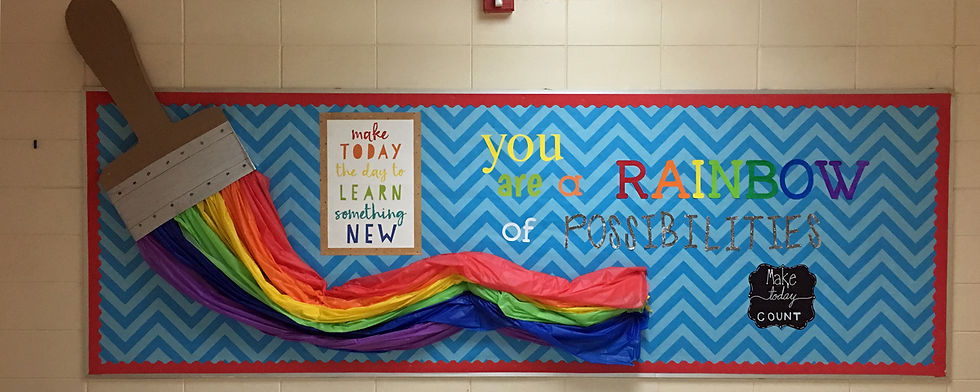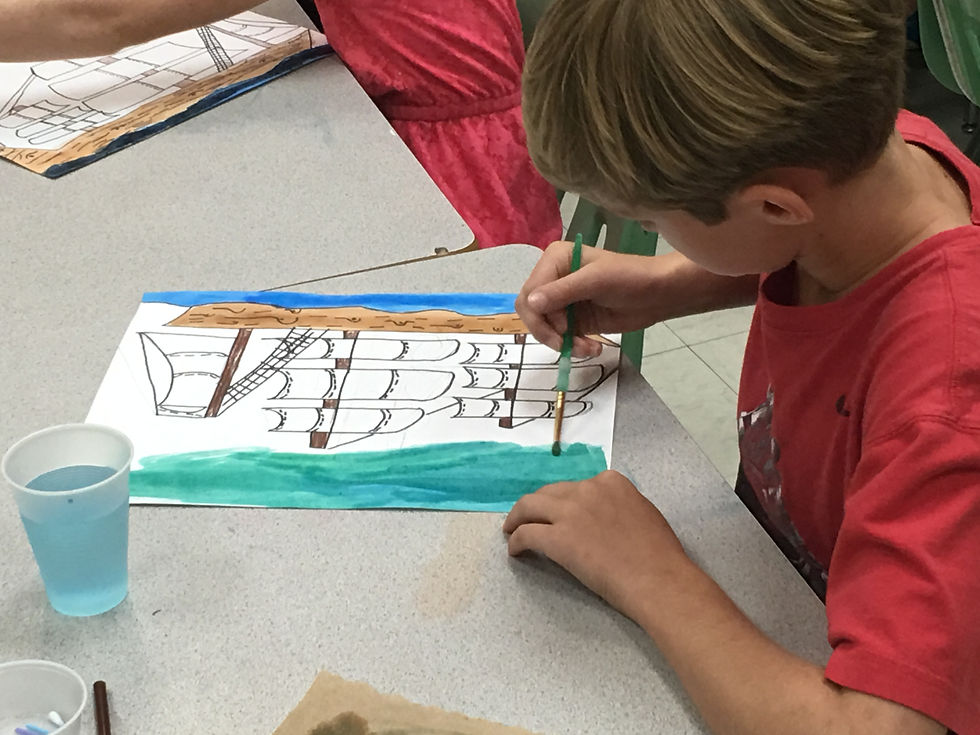

You are a Rainbow of possibilities. Make today count.

Please consider donating to your Wildcat Art room

Fifth Graders Drawing and Painting Clipper Ships

You are a Rainbow of possibilities. Make today count.
Georgia Performance Standards Fine Arts For Fourth Grade
VA4MC.3 Selects and uses subject matter, symbols, and/or ideas to communicate meaning.
Generates different viewpoints for making and interpreting a visual image.
Develops visual images by combining or modifying open-ended themes/topics in unique and innovative ways.
Observes how the visual relationship of objects and ideas (juxtaposition) affects contrast and/or proportion and how placement may affect meaning and/or significance.
CONTEXTUAL UNDERSTANDING
The student understands the visual arts in relation to history and culture (National Standard 4).
The student recognizes the impact of art on history and different cultures and how history and culture have influenced art. The student plans for and participates in a variety of activities that promote personal engagement in the study of art history and culture.
VA4CU.1 Investigates and discovers the personal relationship of artist to the community, the culture, and world through making and studying art.
Recognizes the unique contributions of contemporary and historical Georgia artists and art forms.
Explores and articulates ideas and universal themes from diverse cultures of the past and present.
VA4CU.2 Views and discusses selected artworks.
Identifies elements, principles, themes, and/or time period in a work of art.
Discusses how social events inspire art from a given time period.
PRODUCTION
The student creates artworks by applying media, techniques, and processes to formulate and express his or her ideas and conceptual understandings (National Standard 1).
Experiencing the role of the artist, each student applies media, techniques, and processes to develop basic skills and increase confidence. Through experience in a range of art processes, use of a variety of materials, and development of a repertoire of techniques, the student relates process, material, and technique to the communication of ideas. Media/techniques should include, but are not limited to drawing, painting, sculpture, ceramics, fiber arts, printmaking, and digital. The student should be engaged in well-rounded studio art experiences.
VA4PR.1 Creates artworks based on personal experience and selected themes.
Interprets visually the big ideas (community, identity, nature, justice, conflict) and broad themes (mother and child, love, war, loss, family) in open-ended ways that resonate with personal meaning.
Makes design decisions as the result of conscious, thoughtful planning and choices.
Communicates values, opinions, or personal insights through an original work of art.
Generates artworks to express individual ideas, thoughts, and feelings from memory and/or imagination.
Creates representational art works from direct observation (e.g., landscape, still life, portrait.)
Produces artworks emphasizing one or more elements of art (e.g., space, line, shape, form, color, value, texture)
Combines materials in new and inventive ways to make a finished work of art.
VA4PR.2 Understands and applies media, techniques, and processes of two-dimensional art processes (drawing, painting, printmaking, mixed-media) using tools and materials in a safe and appropriate manner to develop skills.
Produces drawings with a variety of media (e.g., pencils, crayons, pastels, and charcoal).
Creates contour drawing.
Uses shading (changes in value) to create depth and model form.
Captures movement in artworks, such as gesture drawings.
Creates paintings with a variety of media (e.g., tempera, watercolor, acrylic).
Mixes and uses color schemes (analogous, monochromatic, complementary, neutral).
Creates a series of numbered prints.
Creates art works using available technology (e.g., computer, scanner, camera, digital/video recorder).
VA4PR.3 Understands and applies media, techniques, and processes of three-dimensional works of art (ceramics, sculpture, crafts, and mixed-media) using tools and materials in a safe and appropriate manner to develop skills.
Creates 3-D artwork that demonstrates a design concept: open or closed form, proportion, balance, color scheme, and movement.
Creates ceramic objects using hand-building methods (e.g., pinch, coil, slab,) clay processing techniques (e.g., wedge, score and slip) and surface design (e.g., stamping, relief carving, glazing, burnishing)
Creates sculpture/3-dimensional form using selected method/technique (e.g., papier- mâché, paper sculpture, assemblage, found object sculpture).
VA4PR.4 Plans and participates in appropriate exhibition(s) of artworks.
Prepares artwork for exhibition by writing a title, statement, and signature on his or her finished work of art.
Chooses artwork to be displayed.
Attends art exhibits in the school and/or local community.
ASSESSMENT and REFLECTION
The student critiques works of art, reflecting upon and assessing the characteristics and merits of his or her own artwork and the artwork of others (National Standard 5). The student describes and assesses materials, techniques, and processes used to complete a finished artwork. The student demonstrates the ability to reflect upon and interpret the construction of meaning in his or her own artwork and the artwork of others. Interacting with peers, the student expresses and validates a personal viewpoint and offers constructive criticism.
VA4AR.1 Develops and maintains an individual portfolio of artworks.
Distinguishes between complete and incomplete artworks.
Identifies strengths, interests, and areas for improvement as a creator, interpreter, and viewer of art.
VA4AR.2 Uses a variety of approaches to understand and critique works of art.
Develops multiple strategies for responding to and reflecting on artworks (e.g., formal and informal art criticism techniques).
Explains features of a work, including media, subject matter, and formal choices, that influence meaning.
Distinguishes among representational art, abstract art, and non-objective art forms.
Interprets and evaluates artworks through thoughtful discussion and speculation about the mood, theme, and intentions of those who created a work of art.
Demonstrates how shape/form can have radial balance or symmetrical balance.
Writes about art for an audience and captures the feelings represented in words.
VA4AR.3 Explains how selected elements and principles of design are used in an artwork to convey meaning and how they affect personal responses to and evaluation of the artwork.
Uses art terminology with emphasis on the elements of art: space, line, shape, form, color, value, texture.
Uses art terminology with emphasis on the principles of design: balance, proportion, rhythm, emphasis, unity, and contrast.
Recognizes spatial concepts that show depth in art works (e.g., overlapping, placement, size, color, detail) and uses them in a work of art.
Explains how artists use a variety of lines and color values within an artwork to achieve three-dimensional effects (e.g., dimensional line, shading techniques).
Discusses properties of color (e.g., hue, intensity, value), color schemes (e.g., neutral, complementary, analogous, monochromatic, triadic) and properties of color and how they are used in a work of art.
Demonstrates how contrast can be used in a work of art to create emphasis.
Explains the use of positive and negative space in composition.
Describes how repeated colors, lines, shapes, forms, or textures can create pattern and show movement in an artwork.
Demonstrates how the relationship of size between objects affects scale and proportion in a work of art.
Uses adjectives to describe texture.
CONNECTIONS
The student makes connections to other disciplines and the world through the visual arts (National Standard 6). The student makes connections from the world of art to other areas of learning and personal endeavor. The student derives inspiration for art from a variety of content areas. The student informs study and production of art by integrating information and skills from other areas of knowledge and academic disciplines (e.g., math, reading, English Language Arts, social studies, science, music, dance, theater arts, world languages, career awareness, and technology).
VA4C.1 Applies information from other disciplines to enhance the understanding and production of artworks.
Makes interdisciplinary connections applying art skills, knowledge to improve understanding in other disciplines.
Researches, describes, and discusses various art-related careers (e.g., art historian, art critic, curator, web designer, game designer, fine artist).
Describes and discusses design in daily life (e.g., clothing, houses, cars, furniture).
VA4C.2 Develops life skills through the study and production of art.
Manages goals and time.
Adapts to change.
Works in teams.
Guides and lead others.
Directs own learning.
Demonstrates persistence.